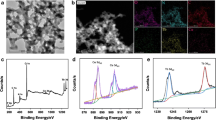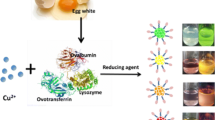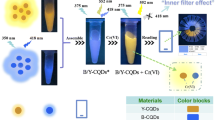Abstract
A smartphone-based ratiometric fluorescence device was designed to monitor the reaction kinetic process under vigorous mixing conditions, demonstrated by the hydrolysis of Cs4PbBr6 nanocrystals (NCs). In the presence of trace water, part of Cs4PbBr6 NCs (non-fluorescent) was converted to CsPbBr3 NCs (strong fluorescent). Using anthracene as the reference fluorophore, the brightness ratio of the green (from CsPbBr3 NCs) to blue (from anthracene) components in the fluorescence image which was recorded in situ by the smartphone camera was measured as the signal for kinetic analysis. It was shown that the water-triggered conversion reaction from Cs4PbBr6 NCs to CsPbBr3 NCs follows the pseudo-second-order kinetic model in the early rapid hydrolysis stage (up to 4 min). With increasing water content, the hydrolysis of Cs4PbBr6 NCs is promoted to yield more CsPbBr3 NCs, which was used to determine trace water in n-hexane, dichloromethane, and toluene with detection limits of 0.031, 0.043, and 0.057 μL mL−1, respectively. The device offers the advantages of portability and low cost for rapid field determination of trace water in hydrophobic organic solvents.

Graphical abstract








Similar content being viewed by others
References
Faheem MB, Khan B, Feng C, Farooq MU, Raziq F, Xiao YQ, Li YB (2020) All-inorganic perovskite solar cells: energetics, key challenges, and strategies toward commercialization. ACS Energy Lett 5:290–320. https://doi.org/10.1021/acsenergylett.9b02338
Chouhan L, Ghimire S, Subrahmanyam C, Miyasaka T, Biju V (2020) Synthesis, optoelectronic properties and applications of halide perovskites. Chem Soc Rev 49:2869–2885. https://doi.org/10.1039/c9cs00848a
Yang C, Wu YH, Ma QS, Zhang WH (2018) Nanocrystals of halide perovskite: synthesis, properties, and applications. J Energy Chem 27:622–636. https://doi.org/10.1016/j.jechem.2017.12.007
Chen YL, Zhang XY, Liu ZF, Zeng ZG, Zhao HB, Wang XH, Xu JQ (2019) Light enhanced room temperature resistive NO2 sensor based on a gold-loaded organic–inorganic hybrid perovskite incorporating tin dioxide. Microchim Acta 186:47. https://doi.org/10.1007/s00604-018-3155-1
Huang YC, Yan FY, Xu JX, Bian YY, Zhang RQ, Wang J, Zhou XG (2017) The FRET performance and aggregation-induced emission of two-dimensional organic- inorganic perovskite, and its application to the determination of Hg(II). Microchim Acta 184:3513–3519. https://doi.org/10.1007/s00604-017-2360-7
Tan L, Guo ML, Tan JA, Geng YY, Huang SY, Tang YW, Su CC, Lin CC, Liang Y (2019) Development of high-luminescence perovskite quantum dots coated with molecularly imprinted polymers for pesticide detection by slowly hydrolysing the organosilicon monomers in situ. Sens. Actuators B 291:226–234. https://doi.org/10.1016/j.snb.2019.04.079
Yang XY, Chen L, Xiong XX, Shu Y, Jin DQ, Zang Y, Wang W, Xu Q, Hu XY (2020) Molecularly imprinted polymers and PEG double engineered perovskite: an efficient platform for constructing aqueous solution feasible photoelectrochemical sensor. Sensors Actuators B Chem 304:127321. https://doi.org/10.1016/j.snb.2019.127321
Liao JF, Xu YF, Wang XD, Chen HY, Kuang DB (2018) CsPbBr3 nanocrystal/MO2 (M = Si, Ti, Sn) composites: insight into charge-carrier dynamics and photoelectrochemical applications. ACS Appl Mater Interfaces 10:42301–42309. https://doi.org/10.1021/acsami.8b14988
Tan X, Zhang B, Zou G (2017) Electrochemistry and electrochemiluminescence of organometal halide perovskite nanocrystals in aqueous medium. J Am Chem Soc 139:8772–8776. https://doi.org/10.1021/jacs.7b05073
Li Z, Kang Q, Chen L, Zhang B, Zou GZ, Shen DZ (2020) Enhancing aqueous stability and radiative-charge-transfer efficiency of CsPbBr3 perovskite nanocrystals via conductive silica gel coating. Electrochim Acta 330:135332. https://doi.org/10.1016/j.electacta.2019.135332
Huang H, Bodnarchuk MI, Kershaw SV, Kovalenko MV, Rogach AL (2017) Lead halide perovskite nanocrystals in the research spotlight: stability and defect tolerance. ACS Energy Lett 2:2071–2083. https://doi.org/10.1021/acsenergylett.7b00547
Huang S, Li Z, Kong L, Zhu N, Shan A, Li L (2016) Enhancing the stability of CH3NH3PbBr3 quantum dots by embedding in silica spheres derived from tetramethyl orthosilicate in “waterless” toluene. J Am Chem Soc 138:5749–5752. https://doi.org/10.1021/jacs.5b13101
Wei Y, Deng X, Xie Z, Cai X, Liang S, Ma PA, Hou Z, Cheng Z, Lin J (2017) Enhancing the stability of perovskite quantum dots by encapsulation in crosslinked polystyrene beads via a swelling-shrinking strategy toward superior water resistance. Adv Funct Mater 27:1703535. https://doi.org/10.1002/adfm.201703535
Hu HC, Wu LZ, Tan YS, Zhong QX, Chen M, Qiu YH, Yang D, Sun BQ, Zhang Q, Yin YD (2018) Interfacial synthesis of highly stable CsPbX3/oxide Janus nanoparticles. J Am Chem Soc 140:406–412. https://doi.org/10.1021/jacs.7b11003
Zhou Y, Zhang DN, Xing WZ, Cuan J, Hu YH, Cao YT, Gan N (2019) Ratiometric and turn-on luminescence detection of water in organic solvents using a responsive europium-organic framework. Anal Chem 91:4845–4851. https://doi.org/10.1021/acs.analchem.9b00493
Liang YY (1990) Automation of Karl Fischer water titration by flow injection sampling. Anal Cham 62:2504–2506. https://doi.org/10.1021/ac00221a018
Xu BQ, Rao CQ, Cui SF, Wang J, Wang JL, Liu LP (2018) Determination of trace water contents of organic solvents by gas chromatography-mass spectrometry-selected ion monitoring. J Chromatogr A 1570:109–115. https://doi.org/10.1016/j.chroma.2018.07.068
Lang SBH, Azizi E, Arjomandi J, Nematollahi D, Massah AR (2018) Fabrication of a novel electrochemical sensor for the determination of water in some organic solvents based on naphthalene conducting polymers. New J Chem 42:14926–14932. https://doi.org/10.1039/c8nj02767f
Yoo H, Kim HS (2019) Real-time colorimetric water content monitoring of organic solvents by an azo dye incorporated into AlPO4-5 nanochannel. J Mater Chem C 7:7336–7343. https://doi.org/10.1039/c9tc01767d
Kumar P, Ghosh A, Jose DA (2019) A simple colorimetric sensor for the detection of moisture in organic solvents and building materials: applications in rewritable paper and fingerprint imaging. Analyst 144:594–601. https://doi.org/10.1039/c8an01042k
Huang D, Bing Y, Yi H, Hong W, Lai C, Guo Q, Niu C (2015) An optical-fiber sensor based on time-gated fluorescence for detecting water content in organic solvents. Anal Methods 7:4621–4628. https://doi.org/10.1039/c5ay00110b
Jung HS, Verwilst P, Kim WY, Kim JS (2016) Fluorescent and colorimetric sensors for the detection of humidity or water content. Chem Soc Rev 45:1242–1256. https://doi.org/10.1039/c5cs00494b
Douvali A, Tsipis AC, Eliseeva SV, Petoud S, Papaefstathiou S, Malliakas CD (2015) Turn-on luminescence sensing and real-time detection of traces of water in organic solvents by a flexible metal-organic framework. Angew Chem Int Ed 54:1651–1656. https://doi.org/10.1002/ange.201410612
Chen L, Ye JW, Wang HP, Pan M, Yin SY, Wei ZW, Zhang LY, Wu K, Fan YN, Su CY (2017) Ultrafast water sensing and thermal imaging by a metal-organic framework with switchable luminescence. Nat Commun 8:15985. https://doi.org/10.1038/ncomms15985
Li BB, Wang WJ, Hong ZX, Sayed ESME, Yuan DQ (2019) Ratiometric fluorescence detection of trace water in an organic solvent based on bimetallic lanthanide metal–organic frameworks. Chem Commun 55:6926–6929. https://doi.org/10.1039/c9cc02324k
Ye CL, Qin YJ, Huang PC, Chen AF, Wu FY (2018) Facile synthesis of carbon nanodots with surface state-modulated fluorescence for highly sensitive and real-time detection of water in organic solvents. Anal Chim Acta 1034:144–152. https://doi.org/10.1016/j.aca.2018.06.003
Wang W, Zhao MY, Wang L, Chen HQ (2019) Core-shell upconversion nanoparticles of type NaGdF4:Yb,Er@NaGdF4:Nd,Yb and sensitized with a NIR dye are a viable probe for luminescence determination of the fraction of water in organic solvents. Microchim Acta 186:630. https://doi.org/10.1007/s00604-019-3744-7
Roda A, Michelini E, Zangheri M, Fusco MD, Calabria D, Simoni P (2016) Smartphone based biosensors: a critical review and perspectives. Trends Anal Chem 79:317–325. https://doi.org/10.1016/j.trac.2015.10.019
Kanchi S, Sabela MI, Mdluli PS, Inamuddin BK (2018) Smartphone based bioanalytical and diagnosis applications: a review. Biosens Bioelectron 102:136–149. https://doi.org/10.1016/j.bios.2017.11.021
Kassal P, Steinberg MD, Steinberg IM (2018) Wireless chemical sensors and biosensors: a review. Sensors Actuators B Chem 266:228–245. https://doi.org/10.1016/j.snb.2018.03.074
You XR, Huang CY, Luo YX, Shi GY, Zhou TS, Deng JJ (2020) A smartphone-based platform for point-of-use determination of alkaline phosphatase as an indicator of water eutrophication. Microchim Acta 187:354. https://doi.org/10.1007/s00604-020-04336-1
Dutta S (2019) Point of care sensing and biosensing using ambient light sensor of smartphone: critical review. Trends Anal Chem 110:393–400. https://doi.org/10.1016/j.trac.2018.11.014
Ruppert C, Phogat N, Laufer S, Kohl M, Deigner HP (2019) A smartphone readout system for gold nanoparticle-based lateral flow assays: application to monitoring of digoxigenin. Microchim Acta 186:119. https://doi.org/10.1007/s00604-018-3195-6
Chen LL, Xu H, Wang L, Li Y, Tian XK (2020) Portable ratiometric probe based on the use of europium(III) coordination polymers doped with carbon dots for visual fluorometric determination of oxytetracycline. Microchim Acta 187:125. https://doi.org/10.1007/s00604-019-4104-3
Wang HH, Sun Y, Li HJ, Yue WW, Kang Q, Shen DZ (2018) A smartphone-based ratiometric resonance light scattering device for field analysis of Pb2+ in river water samples and immunoassay of alpha fetoprotein using PbS nanoparticles as signal tag. Sensors Actuators B Chem 271:358–366. https://doi.org/10.1016/j.snb.2018.05.103
Rezazadeh M, Seidi S, Lid M, Pedersen-Bjergaard S, Yamini Y (2019) The modern role of smartphones in analytical chemistry. Trends Anal Chem 118:548–555. https://doi.org/10.1016/j.trac.2019.06.019
Sun Y, Wei M, Liu R, Wang HH, Li HJ, Kang Q, Shen DZ (2018) A smartphone-based ratiometric fluorescent device for field analysis of soluble copper in river water using carbon quantum dots as luminophore. Talanta 194:452–460. https://doi.org/10.1016/j.talanta.2018.10.019
Matteis FD, Vitale F, Privitera S, Ciotta E, Pizzoferrato R, Generosi A, Paci B, Di Mario L, Cresi JSP, Martelli F, Prosposito P (2019) Optical characterization of cesium lead bromide perovskites. Crystals 9:280. https://doi.org/10.3390/cryst9060280
Bigdeli A, Ghasemi F, Abbasi-Moayed S, Shahrajabian M, Fahimi-Kashani N, Jafarinejad S, Nejad MAF, Hormozi-Nezhad MR (2019) Ratiometric fluorescent nanoprobes for visual detection: design principles and recent advances-a review. Anal Chim Acta 1079:30–58. https://doi.org/10.1016/j.aca.2019.06.035
Hou L, Qin YX, Li JY, Qin SY, Huang YL, Lin TR, Guo LQ, Ye FG, Zhao SL (2019) A ratiometric multicolor fluorescence biosensor for visual detection of alkaline phosphatase activity via a smartphone. Biosens Bioelectron 143:111605. https://doi.org/10.1016/j.bios.2019.111605
Ye YW, Wu TT, Jiang XT, Cao JX, Ling X, Mei QS, Chen H, Han DM, Xu JJ, Shen YZ (2020) Portable smartphone-based QDs for the visual onsite monitoring of fluoroquinolone antibiotics in actual food and environmental samples. ACS Appl Mater Interfaces 12:14552–14562. https://doi.org/10.1021/acsami.9b23167
Petryayeva E, Algar WR (2014) Multiplexed homogeneous assays of proteolytic activity using a smartphone and quantum dots. Anal Chem 86:3195–3202. https://doi.org/10.1021/ac500131r
McKay G, Ho YS (1999) Pseudo-second order model for sorption processes. Process Biochem 34:451–465. https://doi.org/10.1016/S0032-9592(98)00112-5
Ruan LJ, Tang B, Ma Y (2019) Improving the stability of CsPbBr3 nanocrystals in ethanol by capping with PbBr2-adlayers. J Phys Chem C 123:11959–11967. https://doi.org/10.1021/acs.jpcc.9b01645
Funding
This work is supported financially by the National Natural Science Foundation of China (21874083), the Natural Science Foundation of Shandong Province of China (ZR2018MB029), Shandong Peninsula Engineering Research Center of Comprehensive Brine Utilization (2018LS014), and the Weifang Science and Technology Development Plan (2018GX063).
Author information
Authors and Affiliations
Corresponding authors
Ethics declarations
Conflict of interest
The authors declare that they have no competing interests.
Additional information
Publisher’s note
Springer Nature remains neutral with regard to jurisdictional claims in published maps and institutional affiliations.
Electronic supplementary material
ESM 1
(DOCX 2.76 mb)
Rights and permissions
About this article
Cite this article
Li, Z., Chen, X., Yu, L. et al. Monitoring of reaction kinetics and determination of trace water in hydrophobic organic solvents by a smartphone-based ratiometric fluorescence device. Microchim Acta 187, 564 (2020). https://doi.org/10.1007/s00604-020-04551-w
Received:
Accepted:
Published:
DOI: https://doi.org/10.1007/s00604-020-04551-w




